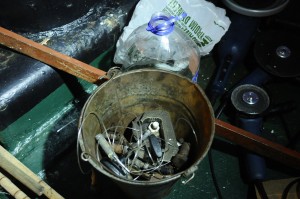
The art world has been abuzz the last couple of months over the performance of “The Artist Is Present,” by Serbian artist Marina Abramović at New York’s MOMA. In the piece, she sits in a chair, nearly motionless, for eight hours a day — no food, no water, not even a bathroom break — and audience members may sit across from her as long as they like. Some have been reduced to tears. To those unfamiliar with Abramović’s past and past work, this is just a woman in a chair. But to know her background is to unlock the meaning of all this nothing.
Abramović has made her career on such feats of strength; in one piece, she lies on a bed, her head hanging over the edge, and screams incessantly until her voice gives. She has whipped herself, cut herself, drugged herself, brushed her hair for hours, and in 1974, she nearly died performing a piece in which she lied inside a 5-pointed star set aflame. In the 90s, to protest the Balkans wars, she sat atop a pile of cow bones and vainly attempted to scrub the flesh from them, her white dress staining yellow and red; we cannot make war clean.
In the most shocking and famous of her performances, she laid out items next to her prostrate body and invited the public to do to her what they would. Most were timid, some cut her clothing, others stuck thorns in her, but a riot nearly ensued when a man pointed the loaded gun she provided at her head. When the show ended, she walked toward the public — and they ran away. A comment on doing nothing while evil festers? A mere step in the direction of her erstwhile tormentors sent them scattering.
The artist’s influences are chiefly the air of Yugoslav nationalism in the postwar years — both parents were popular WWII figures; her great uncle was the patriarch of the Serbian Church — and the stark and dreary oppression of Tito’s communist regime. Abramović came of age under this anti-individualist orthodoxy; might this lead one to experiment further with self-denial, self-imposed stress positions — a popular tool in the torturer’s repertoire — and self-inflicted pain? She participated in a student protest that forced the dictator to convert a military building into an artists’ school, but Yugoslavia proved too stifling, and the young artist fled to Amsterdam in 1976, where she met her future partner Ulay.
On the last day of “The Artist Is Present,” Abramović tumbled out of her chair, lept up and did a twirl, and worked her adoring crowd like a rockstar. As in her life, as in the lives of many others who suffered under tyranny, she broke figurative but stultifying chains — and then did whatever the f*ck she wanted with her new freedom.
Though I saw in person and was amazed by the performance the day before the end of the show, I simply sported an awestruck grin. But just seeing the photos on my computer screen of Marina Abramović reveling in the end of her long and arduous feat made me cry, too.




